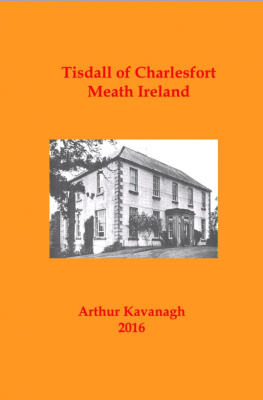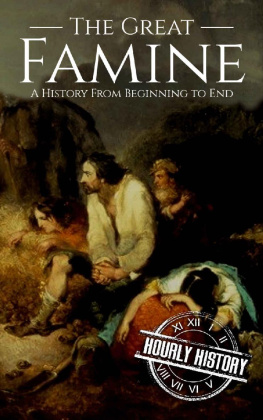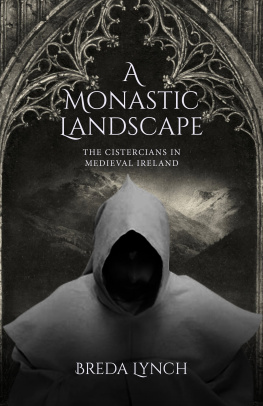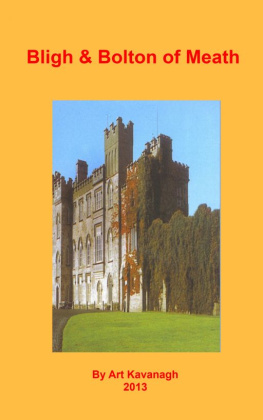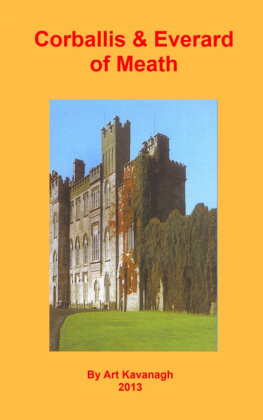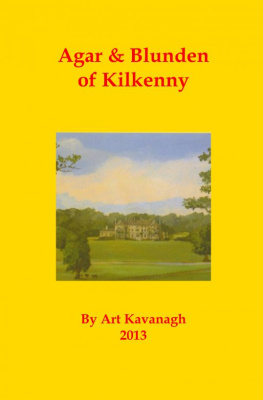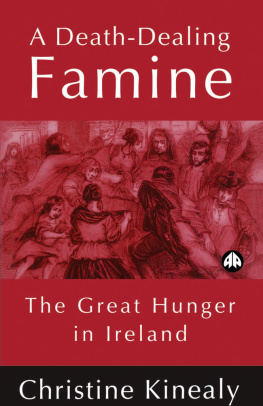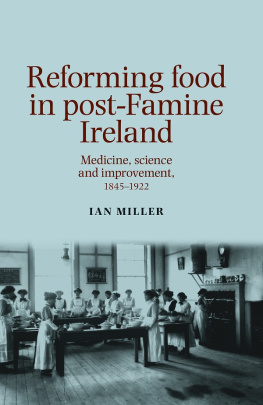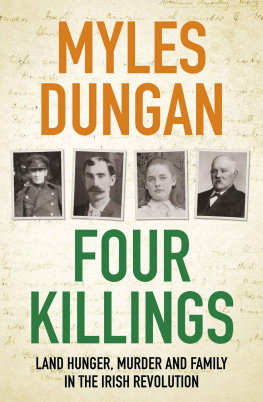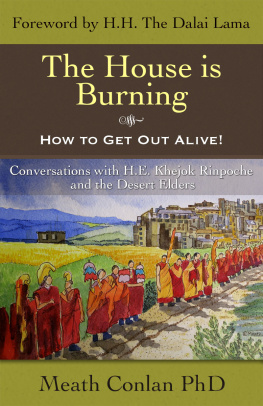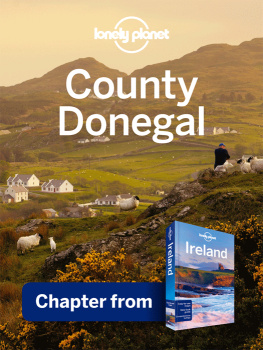Tisdall of Charlesfort Co. MeathIreland
Copyright 2016 Arthur Kavanagh
Published by Arthur Kavanagh at Smashwords
Smashwords Edition License Notes
This ebook is licensed for your personalenjoyment only. This ebook may not be re-sold or given away toother people. If you would like to share this book with anotherperson, please purchase an additional copy for each recipient. Ifyoure reading this book and did not purchase it, or it was notpurchased for your enjoyment only, then please return toSmashwords.com or your favorite retailer and purchase your owncopy. Thank you for respecting the hard work of this author.
Table of Contents
Tisdall of Charlesfort Co. Meath Ireland
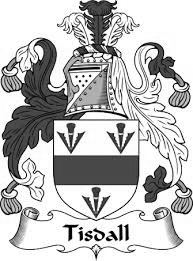
Hugo de Lacy granted the Manor of Martry to aknight named Hugh de Turpleton in the late 12th century. This manorwas situated near Kells in Co. Meath, Ireland. Turpleton built acastle and a church in Martry townland. In the mid 14th century theJusticiar for Ireland, Sir John Darcy was granted a number ofestates in Ireland including the Manor of Martry. The Darcysmanaged to stay in continuous possession of Martry until 1668. Theyhad other properties in Meath also, including Plattin where abranch of the family settled. Being Catholic and having taken partin the War of 1641 the Darcys lost much of their lands. Nicholas, ayoungster in the time of the War was declared an innocent andmanaged to retain lands in the Martry area. However he proved to bea bad manager and having run into debt was forced to lease out hislands in the Martry area in 1668. The lessee was MichaelTisdall.
Michaels father, also called Michael, wasthe first Tisdall in Ireland. He was a tradesman or professionalfrom England. He married a settler woman named Anne Singleton andthey had seven sons and two daughters. His eldest son Michael, bornin 1637 was sent to school in Dublin where he studied law. Whilethere he met his future wife, Anne Barry, the niece of Sir JamesBarry (later Lord Santry) the Chief Justice of the Court of theKings Bench. This fortuitous relationship resulted in marriage andfrom then on young Michaels star was in the ascendant. He was soonpromoted to the position of Secondary of the Court of the KingsBench. When the Martry lands came on the market in 1668 Michaelseized his opportunity and leased the lands from the impoverishedNicholas Darcy.
The Manor of Martry was quite substantial andincluded over a hundred cottages, two windmills and almost 2000acres of land, Irish measure. As Nicholas Darcys woes continuedMichael took the opportunity to acquire the freehold to theproperty in 1672. Michaels brother, James Tisdall, was appointedthe estate manager and continued in that role until 1689 whenMichaels eldest son, William, came of age. Michael appears to havebuilt a house in the townland of Bloomsbury. He changed the name ofthe townland to Mount Tisdall and his house was called MountTisdall also and was effectively the Manor House. Nobody is quitesure if there was a house already in existence in Bloomsbury, butif there was it is likely that it was considerably improved by thenew owner of the estate. Apart from the townland of Mount Tisdall,the rest of the estate was leased to tenants. Michael himselfseldom lived at Mount Tisdall and appears to have lived mainly inDublin where he continued in his official post. In 1679 he was madea Justice of the Peace and in the same year was conferred with armsby the Ulster King of Arms, Richard St. George. During his time inDublin he acquired other properties and a brewery.
The Tisdall arms consist of three pheonsargent on a shield of sable with a thistle. Above this is a handerect, charged with a pellet and holding an arrow. The arm comesout of a crown. The motto reads tutantur tela coronam (The dartsdefend the crown).
Michael II died aged 44 in 1681 and his sonWilliam inherited, but the estate continued to be managed by JamesTisdall until 1690. James, who must have been a very astutemanager, then moved to Ardee, Co. Louth, where he bought an estateat Bawn. James went on to become an M.P. for Ardee and continued inthat position until 1713 when he retired from politics due to illhealth. His position as M.P. was given to his grandnephew, MichaelIII.
Michael II was buried in St. Michans churchin Dublin. From that time onwards the Tisdalls were all buried inthe graveyard adjacent to St. Brigids church in Martry.
The income from the various properties musthave been substantial as William was able to pay dowries for histwo sisters, Catherine and Elizabeth and was able to pay money tohis brother Michael, a barrister, also. In addition he boughtanother townland in the vicinity of Martry, known as Hurdlestown.During the turbulent years of 1689-90 when the Kings James II andWilliam of Orange were contending for the throne of Ireland, youngWilliam Tisdall seems to have kept his head under the parapet.There is no record of any disturbances on his estate.
William, like his father, made sure to marrywell and his bride was none other than Frances Fitzgerald, thesister of the 19th Earl of Kildare. Their eldest son Michael IIIinherited the estate in 1714 when his father retired due to illhealth. He represented Ardee, Co. Louth, in parliament, as alreadyalluded to. Michael III had a brother George who entered thechurch. Michael III left his brother 5 in his will.
In 1719 Michael III married Catherine Palmer,the daughter of William Palmer, an M.P. for Kildare in 1695 and forCastlebar in 1723. He was in very bad health for most of his lifeand in his will he made provisions for his family, leaving themannuities and of course his estates which went to his only sonCharles, who was just seven years of age when his father died in1726. During his minority the estate was managed by the Rev. GeorgeTisdall, Charles Hamilton of Dunboyne and William Waller ofAllenstown.
(1719 1757)
When young Charles was eleven years of age some kindof mini tornado wrought havoc on the estate. Memoirs written by anestate worker Christie Ward tell us that
"On Candlemas Day 1730 commencing about 10o'clock in the morning was that extraordinary storm of wind whoseawfulness never left the mind of those that lived at that time andwas often spoken of by them to their posterity in token of theawful workings of the Almighty. It lasted about 4 hours. It was soextraordinary in its manner for it wrought like a whirlwind liftingup the roofs off the houses just as they were and casting them agreat way off and stacks of corn and cocks of hay it would takethem up by the bottom and carry them away whole as if built uponthe wind, but those that were scattered could never be gatheredagain as it was blown into lakes, rivers and bogs. It was everknown as the Windy Candlemas."
Charles received his later education atTrinity College and came into his inheritance in 1740 having spentsome time abroad in the year previous to that. Charles, although hedidnt live very long either, proved to be one of the most able ofthe Tisdalls. He was a very meticulous man who kept records of allhis dealings. It was he who built the very fine house later knownas Charlesfort.
His mother subsequently married the ReverendDoctor Edward Hudson and she and her daughter, Catherine, wereprovided for under the terms of Michael's will, receiving 70 and60 per annum respectively. Charles also paid Dr Hudson 40 peryear "for lodging and dyeting my sister."
Possibly Charles's estate was denuded oftrees in this storm as he had an interest in enhancing it andfurnishing the gardens and woodland around his new home. He came ofage in October 1740, and his January 1741 accounts record thepurchase of 50 pear trees, 150 apple trees and 1,000 beech trees ata cost of 5.9s.2d. In January 1744 he paid 1 to Grogan of Kellsfor 1,000 oak trees, and the following month he paid 2.5s.10d. toPatrick Lee for 800 ash trees. The following Spring he bought hisgarden seeds from Wm. Buller for 1.9s.5d. and paid out 4. 1s. 0d.for unspecified "forest trees." Seven hundred ash and elm treesfrom Miltown cost 2.2s.4d in January 1746.
Next page
